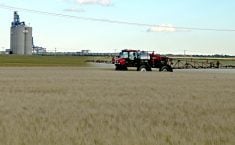MONHEIM, Germany – Friedrich Berschauer took a fat puff on his slim cigar, leaned back in his chair and raised his eyebrows.
The head of one of the world’s largest agricultural chemical companies had just been told that Canadian farm groups and agriculture officials are worried about the lack of new chemistries on the market.
“Honestly, I’m a little bit surprised,” said Berschauer, who is chair of Bayer CropScience.
People like Agriculture Canada weed specialist Eric Johnson have been warning farmers about the lack of available pesticides for years.
Read Also

New coal mine proposal met with old concerns
A smaller version of the previously rejected Grassy Mountain coal mine project in Crowsnest Pass is back on the table, and the Livingstone Landowners Group continues to voice concerns about the environmental risks.
“There’s not much investment in new herbicide discovery with a lot of companies,” he told producers attending Pulse Days 2004.
Earlier this year an official from Berschauer’s own company confirmed that assessment.
Hansjoerg Krahmer, a herbicide researcher with Bayer, told the FarmTech 2007 conference in Edmonton only one herbicide was registered worldwide in 2006, compared to 37 in 2004.
“Many companies have changed their strategic focus by shifting their research resources more into biotechnology activities,” Krahmer said.
“Between 1990 and 2005 there has been a steep decline in new patent applications in our industry.”
However, Berschauer insisted Bayer hasn’t been backing off of its crop protection efforts, a segment that represented 80 percent of company sales for the first half of 2007.
“We are totally committed to crop protection,” he said.
Bayer plans to spend $726 million on crop protection research and development by 2015, which is close to what it spent on the business unit last year.
That represents 66 percent of Bayer’s planned research and development expenditure in 2015, down from 78 percent of the budget in 2006.
Sales of crop protection products floundered in 2006, falling $334 million, or 4.7 percent, largely because of Brazil’s “lousy commodity prices” that year and the appreciation of the real to the U.S. dollar.
However, with widespread cultivation of crops for biofuel and higher commodity prices, sales of Bayer’s crop protection products regained some of that ground in the first half of 2007, growing by 0.5 percent. As well, the company is expecting a strong finish to the year.
Berschauer said the frustration that Canadian growers are experiencing has more to do with painfully slow registration systems and consolidation in the agriculture chemical business than it does with manufacturers producing fewer products.
Bayer introduces an average of two new compounds per year, which includes herbicides as well as fungicides and insecticides. Syngenta is another manufacturer releasing new products on a regular basis.
Sales of the 17 new active ingredients Bayer has launched since 2000 have been particularly strong in the first half of 2007, amounting to $1.15 billion, a 30 percent increase over the same period last year. Those new actives now account for 25 percent of the company’s agrochemical business.
Bayer has 45 crop protection research projects in progress and is aiming to launch four new active ingredients between 2006 and 2008. Another 10 are scheduled for market introduction between 2008 and 2010.
Berschauer said Canadian growers can expect a steady stream of all three classes of pesticides for years to come.
“Innovation in crop protection is the key factor that will enable us to continue safeguarding harvests and yields in the future. A high rate of innovation is also vital if we are to generate added value on a sustainable basis in our company,” he said.

















